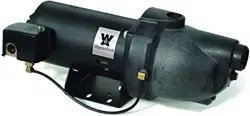Loading ...
Loading ...
Loading ...

11
Hazardous Pressure,
Install pressure relief valve in discharge pipe.
Release all pressure on system before working on any component.
OPERATION
You may have to repeat this two or three times in order
to get all the trapped air out of the piping.
6. As pump begins to build pressure, close faucet. When
water pressure has built up and is maintained
by the pump, slowly close the pressure regulator control
valve while watching the pressure gauge needle.
Continue closing the valve until you see the pressure
gauge needle start to utter. If the needle starts to
utter, slowly open the valve just enough to stop the
utter. Your pump is now operating at peak eciency.
7. Close all open faucets. After the pump has built up
pressure in the system and shut o, check the
pressure switch operation by opening a faucet or two
and running enough water out to bleed o pressure
until the pump starts. If your jet has a 30/50 pressure
switch, the pump should start when the pressure
drops to 30 PSI and stop when pressure reaches 50
PSI. Run the pump through one or two complete cycles
to verify correct operation. This will also help clean the
system of dirt and scale dislodged during installation.
Winterizing
1. Turn o power and open faucets to relieve system
pressure.
2. Drain pump of all winter and leave drain plug out
until restarting pump.
Risk of burns. Never run pump dry. Running
pump without water may cause pump to overheat, damag-
ing seal and possibly causing burns to persons handling
pump. Fill pump with water before starting.
Be sure the pump is full of water before
starting the motor.
Risk of explosion and scalding. Never run
pump against closed discharge. To do so can boil water
inside pump, causing hazardous pressure in unit, risk of
explosion and possible scalding persons handling pump.
1. Open the faucet and pressure regulator control valve
as far as possible. Remove the priming plug from the
pump and ll the pump, ll all piping between the pump
and the well, and make sure that all piping in the well is
full. If you have also installed a priming tee in the suction
piping, remove the plug from the tee and ll the suction
piping.
2. Replace all ll plugs. Leave the pressure regulator control
valve open (in a shallow well installation, the pressure
regulator control valve always stays open).
3. Turn electric power on.
4. Start the pump. The pump should pump water in two
or three minutes.
5. If you don’t have water after 2 to 3 minutes, stop the
pump and remove the ll plugs. Rell the pump and
piping. You may have to repeat this two or three times
in order to get all the trapped air out of the piping. The
control valve remains open throughout this procedure.
6. As pump begins to build pressure, close faucet. Pump
should continue to build pressure until pressure switch
shuts o. Check the pressure switch operation by
opening a faucet or two and running enough water out
to bleed o pressure until the pump starts. If your jet
has a 30/50 pressure switch, the pump should start
when the pressure drops to 30 PSI and stop when
pressure reaches 50 PSI. Run the pump through one or
two complete cycles to verify correct operation. This will
also help clean the system of dirt and scale dislodged
during installation.
PREPARING TO START THE PUMP - SHALLOW WELL
PREPARING TO START THE PUMP - DEEP WELL CONVERTIBLE
Risk of burns. Never run pump dry.
Running pump without water may cause pump to overheat,
damaging seal and possibly causing burns to persons
handling pump. Fill pump with water before starting.
Be sure the pump is full of water before
starting the motor.
Risk of explosion and scalding. Never
run pump against closed discharge. To do so can boil water
inside pump, causing hazardous pressure in unit, risk of
explosion and possibly scalding persons handling pump.
1. Open the pressure regulator control valve as far as
possible. Then remove the priming plug from the pump
and ll the pump, ll all piping between the pump and the
well, and make sure that all piping in the well is full.
If you have also installed a priming tee in the suction
piping, remove the plug from the tee and ll the suction
piping.
2. Replace all plugs.
3. Turn electric power on.
4. Start the pump and watch the pressure gauge. The
pressure should build rapidly to 50 PSI as the pump
primes.
5. Open several faucets in the residence to permit water
ow and to release trapped air. After 2 or 3 minutes, the
gauge should show pressure. If not, stop the pump,
remove the ll plugs, and rell the pump and piping.
!
!
!
!
!
!
Loading ...
Loading ...
Loading ...
